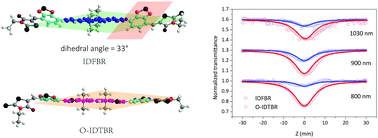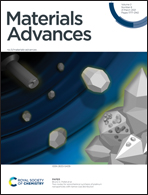Highly broadband NLO response of acceptor–donor–acceptor materials with a planar conformation†
Abstract
The third-order nonlinear optical properties of A–D–A structural molecules which are originally used as acceptors in organic photovoltaic (OPV) devices were investigated in solution and film to deeply understand the molecular conformation–property relationship. Firstly, a planar structure (O-IDTBR) bearing the indacenodithiophene (IDT) core and a twisted molecule (IDFBR) comprising the indenofluorene (IDF) core, which possess identical acceptor units, were measured by the Z-scan technique at the near-infrared region in toluene solution. O-IDTBR exhibits a more superior TPA cross section than IDFBR in the range of 800–1030 nm (ca. 1497–8811 GM). In particular, the TPA cross section of the planar configuration is 8811 GM, over 4 times that of the twisted molecule at 800 nm. Secondly, their corresponding spin-coating films are investigated via a 4f coherent imaging experiment at 532 nm. It is noticeable that the nonlinear refractive index of the planar molecule is up to 2.09–2.15 × 10−15 m2 W−1, which is nearly 5 times that of IDFBR. The dynamic processes and morphologies of films are systematically characterized by transient absorption spectroscopy and AFM. The investigations present a better understanding of the structure–property relationship of the A–D–A conjugated materials which are believed to have promising NLO application in the future.



 Please wait while we load your content...
Please wait while we load your content...